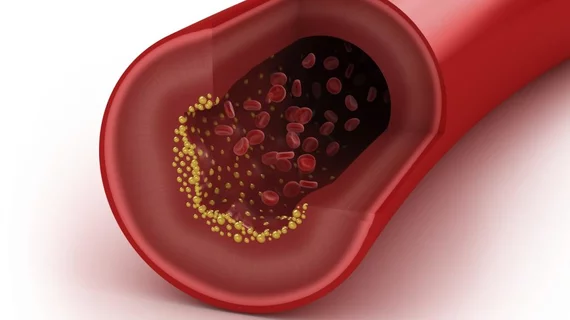Combining ultrasound elastography and echogenicity analysis may better distinguish between plaques in patients with symptomatic internal carotid artery (ICA) stenosis than in those without symptoms, according to an Aug. 30 study in the American Journal of Roentgenology.
Guy Cloutier, with the University of Montreal in Quebec, Canada, and colleagues included 66 patients with carotid stenosis in the study (26 were symptomatic, 40 were asymptomatic). All involved had ICA stenosis of more than 50 percent.
The team set out to evaluate methods of measuring plaque echogenicity and to determine whether biomarkers such as translation motion, strain and shear assessed using ultrasound elastography were associated with symptoms of ischemia in patients with atherosclerotic ICA stenosis, according to the authors.
“Application of this ultrasound method to unstable plaques could identify patients with symptomatic ICA stenosis with poorer cognitive performance presumably related to carotid emboli in silent stroke,” Cloutier and colleagues wrote. “Moreover, plaque texture features could differentiate symptomatic from asymptomatic carotid artery plaques.”
Overall, Cloutier et al. found combining both ultrasound elastography and echogenicity superior at detecting vulnerable plaques in symptomatic patients than each method alone, achieving a sensitivity of 71.6 percent and a specificity of nearly 80 percent.
Additionally, the team determined the maximum axial strain (parameter of stenosis less than 0.001), maximum axial shear strain magnitude (p equals 0.03) and percentage of low-intensity of gray level (0.01) of the index ICA were all lower in patients with symptoms than those without.
In each group, the authors noted, the contralateral ICA had translation, elastography and echogenicity measures similar to those of the index ICA in patients with asymptomatic stenosis.
Cloutier and colleagues cited the absence of histopathologic results to compare plaque content to elastography and echogenicity biomarkers as a limitation, but concluded the combined method superior to elastography or echogenicity alone.
“This pilot study establishes the usefulness of combining elastography with echogenicity analysis to discriminate plaques in patients with symptomatic ICA stenosis versus asymptomatic stenosis,” the authors concluded.

